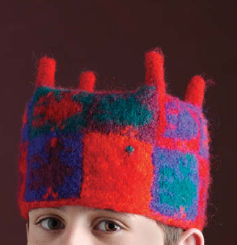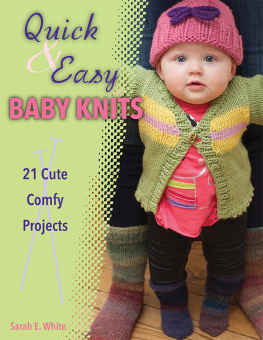VICKI SQUARE
FOLK HATS
32 KNITTING PATTERNS & TALES FROM AROUND THE WORLD


Editor: Ann Budd
Technical Editor: Jean Lampe
Illustration: Vicki Square and Gayle Ford
Photography: Joe Coca
Photostyling: Ann Swanson
Cover and interior design: Susan Wasinger
Production: Pauline Brown
Proofreading and indexing: Nancy Arndt
2005 Vicki Square
Illustrations 2005 Vicki Square and Interweave Press LLC
Photography 2005 Joe Coca and Interweave Press LLC

| Interweave Press LLC 201 East Fourth Street Loveland, Colorado 80537-5655 USA interweave.com |
Library of Congress Cataloging-in-Publication Data
Square, Vicki, 1954
Folk hats : 32 knitting patterns and tales from around the world / Vicki Square.
p. cm.
Includes bibliographical references and index.
ISBN 978-1-931499-63-7 (pbk.)
ISBN 978-1-62033-035-7 (PDF)
ISBN 978-1-62033-237-5 (ePub)
1. KnittingPatterns. 2. Hats. I. Title.
TT825.S7137 2005
746.4320432dc22
2005003008
Contents





H ATS ARE MAGICAL . In the twinkling of an eye, a hat can transport you to another place, another state of mindyou can step into a grand adventure through the simple act of putting on a hat. And wearing a hat is not only a means of self-expression, its an invitation to assume the hats character and mystique.
Hats are powerful. Reflect on famous people whose headwear signifies their historical importance. Nefertiti, ancient Egypts most famous queen, is the embodiment of regal beauty. The elegant line of her elongated neck travels upward to her stunning profile to the flat top of her royal tahj, an inverted cone headdress. That royal blue crown is an inseparable part of our image of the queen. Likewise, Rembrandt van Rijn, the famous Renaissance artist, cannot be dissociated from his large, softly gathered beret, with which he personifies an elevated aesthetic. The Samurai warrior achieves his fiercest countenance when, after donning all the many layers of his armor, he places the kabuto on his head, the final and authoritative statement of his power. And who could imagine Babe Ruth, the most famous player in baseball history, without the telltale crown of his Yankees cap?
Hats precede us. A hat speaks volumes before its wearer utters a word. Casual, relaxed headwear speaks the language of everyday, a wearer completely comfortable with the tasks and focus of daily activities. The hat becomes included as an intimate part of the body, as familiar as face and hands. Conspicuous in their demand for serious attention, hats for formal ceremony or ritual extend the body. Formal hats are generally more complex in creative definition and more spectacular in presentation. They are fashioned with a distinct purpose: to project authority, define status, or designate profession. But in all cases, hats project a quality of character that must be reckoned with.
Hats come in many shapes and sizes, but all spring from one of two categories: a crown with a brim and a crown without a brim. Crowns may be rounded, like the skullcap without a brim or the Panama with a brim, or flat-topped as in a pillbox (thanks to Jackie Kennedy for giving the pillbox its fame). Flat-topped crowns are defined by the structure of their sides and top. Brims may be narrow, they may be wide. Hats may be structured, they may be soft. The rich artistic traditions of cultures from around the world give rise to endless varieties of hats, from very simple to elaborate and complex.
Wander with me in an armchair tour from North America to South America. Sail over to Africa; travel north to Continental Europe and the United Kingdom. Trek farther north into the Scandinavian countries, turning o cross over the frigid landscape of Russia. Drop down into Central Asia, and complete this winding course in the exotic Far East. I draw from a wealth of visual inspiration displayed in these cultures spanning the globe, letting a motif, a texture, a shape, or a color palette be my springboard into my own interpretation. The thread of continuity in my pursuits is that virtually every country has delightful headcoverings. They are elegant in their simplicity, playful in their whimsy, dramatic in their boldness, and rich in their artistry.
In this book, youll find a wide range of hat styles, techniques, and sizes. The smallest is the Nigerian baby hat, the largest is the American cowboy hat, the most simple is the Kazakhstan pillbox, the most complex... well, youll have to determine that for yourself. Theres plenty of daily wear and ceremonial wonder from which to choose.
I had a glorious time creating this collection for you; I hope you are inspired to make and wear any or all of these hats. Even if you dont think of yourself as a hat person, step outside the (hat)box and give them a whirl. All you need to wear a hat well is a willing headand a sense of adventure!

Anatomy of a Hat
Just as all knitting is made up of two basic stitches (knit and purl), all hats are made up of two basic stylesthose with a brim and those without. Beyond that, hat shapes vary widely, but share basic terms to describe similar parts.
The Crown is the portion of a hat that covers the headthe crown top sits at the top of the head; the base of the crown is the part that fits around the head. Crowns may be rounded or structured with defined straight hat sides, also called crown sides or sideband, and a flat top (sometimes called a tip ). The brim is the part of the hat that extends away from the crown at the base, and may be found in a wide variety of width and curve options.

BOWLER

BERET

CORDOBES

PILLBOX
Types of Hats
Throughout history, there have been hundreds of hat shapes, and each has been given a specific identifying name. Working to create innovative head coverings, my design collection is a sampling of some common, and many uncommon, types.
Next page




















